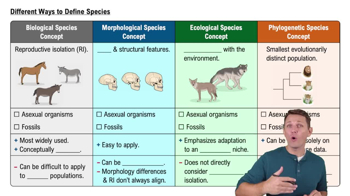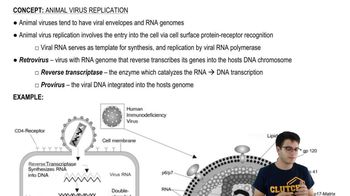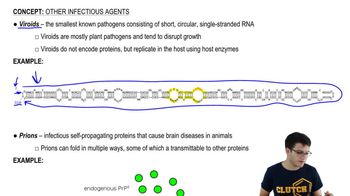Table of contents
- 1. Introduction to Biology2h 42m
- 2. Chemistry3h 40m
- 3. Water1h 26m
- 4. Biomolecules2h 23m
- 5. Cell Components2h 26m
- 6. The Membrane2h 31m
- 7. Energy and Metabolism2h 0m
- 8. Respiration2h 40m
- 9. Photosynthesis2h 49m
- 10. Cell Signaling59m
- 11. Cell Division2h 47m
- 12. Meiosis2h 0m
- 13. Mendelian Genetics4h 44m
- Introduction to Mendel's Experiments7m
- Genotype vs. Phenotype17m
- Punnett Squares13m
- Mendel's Experiments26m
- Mendel's Laws18m
- Monohybrid Crosses19m
- Test Crosses14m
- Dihybrid Crosses20m
- Punnett Square Probability26m
- Incomplete Dominance vs. Codominance20m
- Epistasis7m
- Non-Mendelian Genetics12m
- Pedigrees6m
- Autosomal Inheritance21m
- Sex-Linked Inheritance43m
- X-Inactivation9m
- 14. DNA Synthesis2h 27m
- 15. Gene Expression3h 20m
- 16. Regulation of Expression3h 31m
- Introduction to Regulation of Gene Expression13m
- Prokaryotic Gene Regulation via Operons27m
- The Lac Operon21m
- Glucose's Impact on Lac Operon25m
- The Trp Operon20m
- Review of the Lac Operon & Trp Operon11m
- Introduction to Eukaryotic Gene Regulation9m
- Eukaryotic Chromatin Modifications16m
- Eukaryotic Transcriptional Control22m
- Eukaryotic Post-Transcriptional Regulation28m
- Eukaryotic Post-Translational Regulation13m
- 17. Viruses37m
- 18. Biotechnology2h 58m
- 19. Genomics17m
- 20. Development1h 5m
- 21. Evolution3h 1m
- 22. Evolution of Populations3h 52m
- 23. Speciation1h 37m
- 24. History of Life on Earth2h 6m
- 25. Phylogeny2h 31m
- 26. Prokaryotes4h 59m
- 27. Protists1h 12m
- 28. Plants1h 22m
- 29. Fungi36m
- 30. Overview of Animals34m
- 31. Invertebrates1h 2m
- 32. Vertebrates50m
- 33. Plant Anatomy1h 3m
- 34. Vascular Plant Transport1h 2m
- 35. Soil37m
- 36. Plant Reproduction47m
- 37. Plant Sensation and Response1h 9m
- 38. Animal Form and Function1h 19m
- 39. Digestive System1h 10m
- 40. Circulatory System1h 57m
- 41. Immune System1h 12m
- 42. Osmoregulation and Excretion50m
- 43. Endocrine System1h 4m
- 44. Animal Reproduction1h 2m
- 45. Nervous System1h 55m
- 46. Sensory Systems46m
- 47. Muscle Systems23m
- 48. Ecology3h 11m
- Introduction to Ecology20m
- Biogeography14m
- Earth's Climate Patterns50m
- Introduction to Terrestrial Biomes10m
- Terrestrial Biomes: Near Equator13m
- Terrestrial Biomes: Temperate Regions10m
- Terrestrial Biomes: Northern Regions15m
- Introduction to Aquatic Biomes27m
- Freshwater Aquatic Biomes14m
- Marine Aquatic Biomes13m
- 49. Animal Behavior28m
- 50. Population Ecology3h 41m
- Introduction to Population Ecology28m
- Population Sampling Methods23m
- Life History12m
- Population Demography17m
- Factors Limiting Population Growth14m
- Introduction to Population Growth Models22m
- Linear Population Growth6m
- Exponential Population Growth29m
- Logistic Population Growth32m
- r/K Selection10m
- The Human Population22m
- 51. Community Ecology2h 46m
- Introduction to Community Ecology2m
- Introduction to Community Interactions9m
- Community Interactions: Competition (-/-)38m
- Community Interactions: Exploitation (+/-)23m
- Community Interactions: Mutualism (+/+) & Commensalism (+/0)9m
- Community Structure35m
- Community Dynamics26m
- Geographic Impact on Communities21m
- 52. Ecosystems2h 36m
- 53. Conservation Biology24m
17. Viruses
Viruses
Problem 2`
Textbook Question
Emerging viruses arise by
a. Mutation of existing viruses.
b. The spread of existing viruses to new host species.
c. The spread of existing viruses more widely within their host species.
d. All of the above.
 Verified step by step guidance
Verified step by step guidance1
Understand the concept of 'emerging viruses': Emerging viruses are those that have recently appeared within a population or those whose incidence or geographic range is rapidly increasing.
Consider option a: Mutation of existing viruses. Viruses can mutate rapidly, leading to new strains that may be more infectious or evade the immune system, contributing to their emergence.
Consider option b: The spread of existing viruses to new host species. When a virus jumps from its original host species to a new one, it can lead to the emergence of new viral diseases in the new host population.
Consider option c: The spread of existing viruses more widely within their host species. Increased transmission within a host species can lead to higher incidence rates and potentially new outbreaks, contributing to the virus being considered 'emerging'.
Evaluate option d: All of the above. Since all the previous options (a, b, and c) describe mechanisms by which viruses can emerge, this option suggests that emerging viruses can arise through any or all of these processes.
 Verified video answer for a similar problem:
Verified video answer for a similar problem:This video solution was recommended by our tutors as helpful for the problem above
Video duration:
1mPlay a video:
Was this helpful?
Key Concepts
Here are the essential concepts you must grasp in order to answer the question correctly.
Viral Mutation
Viral mutation refers to changes in the genetic material of a virus, which can occur during replication. These mutations can lead to new viral strains with different characteristics, potentially increasing their ability to infect hosts or evade immune responses. Understanding viral mutation is crucial for comprehending how new viral variants emerge and adapt.
Recommended video:
Guided course

Mutations
Host Species Jumping
Host species jumping, or zoonosis, occurs when a virus that typically infects one species adapts to infect a different species. This process can lead to the emergence of new viral diseases in humans or other animals. It often involves genetic changes that allow the virus to overcome species-specific barriers to infection.
Recommended video:

Biological Species Concept
Viral Spread Within Host Species
The spread of viruses within a host species involves the transmission of the virus among individuals of the same species. Factors such as population density, social behavior, and environmental conditions can influence how widely a virus spreads. Understanding these dynamics is essential for controlling outbreaks and preventing widespread transmission.
Recommended video:

Different Ways to Define Species
Related Videos
Related Practice

































































![Plaque Assay: Assay for estimating viral titre or viral concentration [plaque forming units / mL]](https://img.youtube.com/vi/zFqyaoLQbxQ/mqdefault.jpg)
































